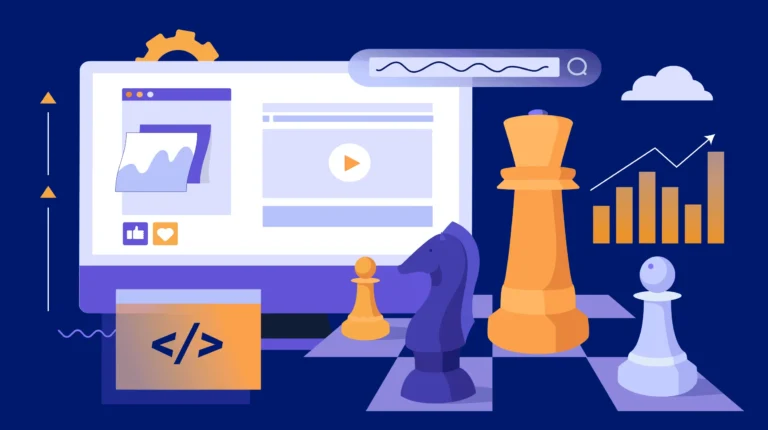
With the overwhelming amount of information available in today’s world, keeping users’ attention is as crucial as securing your place as the most reliable web hosting provider. A visual hierarchy in web design makes it easy to guide users through the information, assisting users in finding what they are looking for.
Your website does not just require an inexpensive web hosting plan. The user interface plays an important role. Design elements that are properly placed enhance user experience, boost engagement, and improve communications, adding life to your site. In this informative and brief post, you’ll discover the most important tips to help you establish the visual hierarchy of web design and improve the performance of your website hosting.
Table of Contents
Understanding Visual Hierarchy
This design principle reinforces the design principle of paying attention. Visual hierarchy occurs when an arrangement is created in a manner that creates an order.
The intentional arrangement helps users can easily find the information they need. If there isn’t a clear and sufficient visual hierarchy, information can be overwhelming and uninteresting.
Elements That Impact Web Design’s Visual Hierarchy
Size and Scale
Attention is drawn to bigger elements. Headings, subheadings and body text separation enable users to quickly see the structure of the text. Users are able to be fully attracted by headlines, and as the text gets smaller, the supporting details show their own, which effectively achieves this aim. This format guides readers to the main message without forcing users to go through additional information.
Contrast and color
The color scheme and the intensity greatly impact the clarity of the elements. For instance, a higher contrast between text and background enhances the readability of text. Color can be employed effectively in order to draw attention to relevant text or other crucial information.
For instance, a user’s interest is more likely to be attained by buttons that are well-colored and placed over a neutral background. However, the use of colors must be controlled by appropriate methods of usability to ensure that users can access the application in a similar way.
Typography
A visual hierarchy created by a variety of fonts sizes, weights, and styles. Utilizing separate typography for various sections, such as headings or body text, allows users to effortlessly scan through the content.
A bold font bigger for the title and with an edgier tone with a smaller font size for the body text will create an attractive and easy to digest structure. The people who read the text will also acquire a certain level of trust and confidence if an appropriate and consistent style of typography is followed and maintained.
Whitespace (Negative Space)
White spaces are spaces that are not marked between design elements. Utilizing whitespace in a proper manner enhances usability since it removes clutter and lets the design “breathe” so that users are able to focus on specific elements that make up the layout.
Whitespace can also be useful in distinguishing the different parts in the design, making it cleaner and improving the way designs and patterns are perceived. Additionally, whitespace can serve various other functions, including making clear important details and steps that must be done.
Alignment and Proximity
An accurate alignment gives you an attractive appearance, while grouping can allow for related elements to be catalogued. The grouping of items provides an organized context and creates an elegant style at the same. For easy comprehension it is best to group the picture of a product along with the description and price. Alignment is a key factor in achieving a professional appearance that the site to achieve.
Visual Hierarchy’s Effect on User Experience
User experience will be improved when there is a clear and open visual hierarchy, for these reasons:
Improved Navigation
Information is more easily retrieved by a well-organized structure. The amount of work a user puts into their mental process is reduced significantly. For instance the restaurant’s website features a distinct menu tab, guests can locate it easily. Additionally, having a clearly defined website map could serve the function too.
Increased Engagement
Interactive elements in design can encourage users to pay focus on the design. The more interesting an image has, the greater people are likely to engage with it. For instance, a multicolored registration form for new accounts will lead to more registrations. Engagement metrics typically depend on how efficiently the visual hierarchy on a website focuses the attention of users.
Improved Use
This design is able to achieve advanced accessibility by taking into account people with different levels of ability. It incorporates readable typefaces as well as design logic, contrast, which enhances the accessibility of visually impaired individuals. Conformity to these standards does not just benefit the appeal of a particular audience, but also displays social responsibleness.
Real-Life Uses of Carousel Layouts
Calls to Action (CTA) Buttons
Conversions are heavily dependent on CTAs. Their visibility can be controlled by their dimension and colour, their position within the text block and so on. For example, CTAs can be placed just above the fold, or with a prominent color to make them more likely to take notice. Additionally, clear and actionable words are essential in the copy of a CTA, and it determines the actions required.
Form Design
The usability of a form can be greatly enhanced by clearly highlighting the most important information fields. Fields that require attention must be highlighted along with a clear explanation to reduce user overload which will reduce the amount of abandoning forms. Additionally, grouping personalized fields and validation messages makes the form more user-friendly.
Content Organization
Users are more engaged and have greater retention when information is separated by bullet points, headings and illustrations that use light. If content is well-structured, it will be more easily read since scanning increases with readability. The inclusion of multimedia, like videos or images, can enhance the content and appeal to a variety of learning styles.
Conclusion
Visual hierarchy aids in the understanding of the content on a site that makes it an essential idea of web design. Designers who are meticulously using the concepts of color, size, whitespace, typography, and alignment can provide seamless and pleasant user experience.
Visual hierarchy can enhance the look of websites, but most importantly, it aids users to take certain actions, while ensuring that the information is easy to locate and appealing. It is essential to realize that in this age of intense competition on the internet knowing the visual hierarchy will result in better engagement with the users and helps to achieve the objectives of the company.






